NAEP 2024 Appendix K
National Assessment of Educational Progress (NAEP) 2024 Amendment #4
NAEP 2024 Appendix K
OMB: 1850-0928
NATIONAL CENTER FOR EDUCATION STATISTICS
NATIONAL ASSESSMENT OF EDUCATIONAL PROGRESS
National Assessment of Educational Progress (NAEP) 2024
Appendix K
2019 Student, Teacher, and School NIES Questionnaires
OMB# 1850-0928 v.29
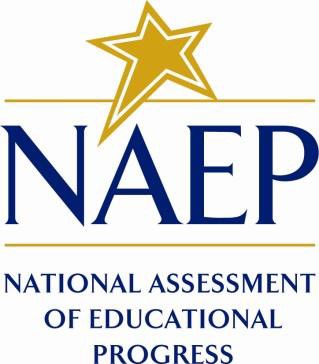
March 2023
no updates since v.28
This document provides a sample from 2019 (OMB# 1850-0928 v.11 approved 10/26/2018). Finalized NIES survey questionnaires will be available in Amendment #3 by July 2023.
Table of Contents
Student Operational Grade 4 NIES 3
Student Operational Grade 8 NIES 11
Teacher Operational Grade 4 NIES 22
Teacher Operational Grade 8 NIES 33
School Operational Grade 4 NIES 45
School Operational Grade 8 NIES 52
Student Operational Grade 4 NIES
VH240128
1. How much do you know about your American Indian tribe or Alaska Native
group? For example, you may know about the history, traditions, or arts and crafts
of your tribe or group.
A Nothing
B A little
C Some
D A lot
VH240129
2. Who taught you most of what you know about American Indian or Alaska Native
history?
A No one has taught me about American Indian or Alaska Native history.
B Family members
C Friends
D Teachers
E Tribal representatives or elders
F Someone else (please specify):
VH240130
3. Who taught you most of what you know about American Indian or Alaska Native
traditions (ways of life, customs)?
A No one has taught me about American Indian or Alaska Native traditions.
B Family members
C Friends
D Teachers
E Tribal representatives or elders
F Someone else (please specify):
VH240131
4. Who taught you most of what you know about American Indian or Alaska Native
arts and crafts?
A No one has taught me about American Indian or Alaska Native arts and crafts.
B Family members
C Friends
D Teachers
E Tribal representatives or elders
F Someone else (please specify):
VH240132
5. How often do you go to American Indian or Alaska Native ceremonies and
gatherings?
A Never
B Every few years
C At least once a year
D Several times a year
VH240133
6. How often do members of your family talk to each other in your American Indian
or Alaska Native language?
A Never or hardly ever
B Once or twice a month
C Once or twice a week
D Every day or almost every day
VH240134
7. How often do people in your school talk to each other in your American Indian or
Alaska Native language?
A Never or hardly ever
B Once or twice a month
C Once or twice a week
D Every day or almost every day
VH240135
8. How often do you attend classes in school that are taught in an American Indian or
Alaska Native language?
A My school does not offer classes that are taught in an American Indian or Alaska Native
language.
B Never or hardly ever
C Once or twice a month
D Once or twice a week
E Every day or almost every day
VH240136
9. How do you rate yourself in speaking an American Indian or Alaska Native
language?
A I cannot speak an American Indian or Alaska Native language.
B I can speak a few words or phrases.
C I can speak well.
VH240137
10. How do you rate yourself in reading an American Indian or Alaska Native
language?
A I cannot read in an American Indian or Alaska Native language.
B I can read a few words or phrases.
C I can read well.
VH240138
11. Who taught you most of what you know about an American Indian or Alaska
Native language?
A No one has taught me about an American Indian or Alaska Native language.
B Family members
C Friends
D Teachers
E Tribal representatives or elders
F Someone else (please specify):
VH240139
12. During 4th grade, have you attended school field trips to museums, traditional
villages, or other places to learn about American Indian or Alaska Native people?
A Yes
B No
VH240140
13. During 4th grade, have you used books, videos, or other materials (including
Internet resources) about American Indian or Alaska Native people in school?
A Yes, once or twice
B Yes, three or more times
C No
VH240141
14. During 4th grade, have you used books, videos, or other materials (including
Internet resources) about American Indian or Alaska Native people
outside of school?
A Yes, once or twice
B Yes, three or more times
C No
VH240142
15. In school, do you have access to a library, media center, or resource center with
books, videos, or other materials (including Internet resources) about American
Indian or Alaska Native people?
A Yes
B No
VH240143
16. When my teacher talks about American Indian or Alaska Native history or culture,
I try to read more about it.
A This is not like me.
B This is a little like me.
C This is a lot like me.
VH240144
17. I enjoy reading about American Indian or Alaska Native people.
A This is not like me.
B This is a little like me.
C This is a lot like me.
VH240145
18. I enjoy reading about people who have different traditions and cultures (ways of
life, customs) than I have.
A This is not like me.
B This is a little like me.
C This is a lot like me.
VH240146
19. I put a lot of effort into my schoolwork.
A This is not like me.
B This is a little like me.
C This is a lot like me.
VH240147
20. I want to be one of the best students in my class.
A This is not like me.
B This is a little like me.
C This is a lot like me.
VH240148
21. I enjoy being challenged in my classes.
A This is not like me.
B This is a little like me.
C This is a lot like me.
VH240149
22. I feel that I belong at school.
A This is not like me.
B This is a little like me.
C This is a lot like me.
VH240150
23. If I put in enough effort, I will succeed in school.
A Strongly disagree
B Disagree
C Agree
D Strongly agree
VH240151
24. Trying hard in school will help me live a good life when I grow up.
A Strongly disagree
B Disagree
C Agree
D Strongly agree
VH240152
25. How often does a parent or someone else from your family help you with your
schoolwork? For example, they might help you to study for a test, help you with a
school project, or go over your homework with you.
A Never or hardly ever
B Once or twice a month
C Once or twice a week
D Every day or almost every day
VH240153
26. How often does a teacher or another adult from your school help you with your
schoolwork? For example, they might help you to study for a test, help you with a
school project, or go over your homework with you.
A Never or hardly ever
B Once or twice a month
C Once or twice a week
D Every day or almost every day
VH240154
27. How often does another student from your school help you with your schoolwork?
For example, they might help you to study for a test, help you with a school
project, or go over your homework with you.
A Never or hardly ever
B Once or twice a month
C Once or twice a week
D Every day or almost every day
VH240155
28. How often do you help other students from your school with their schoolwork?
For example, you might help other students to study for a test, help them with a
school project, or go over their homework with them.
A Never or hardly ever
B Once or twice a month
C Once or twice a week
D Every day or almost every day
VH240156
29. How much do you like school?
A Not at all
B A little
C Somewhat
D Very much
VH240157
30. Do you know the name of the American Indian tribe or Alaska Native group you
belong to or are enrolled in?
A Yes
B No
C I’m not sure.
VH242881
31. If you know the name of the American Indian tribe or Alaska Native group that
you belong to or are enrolled in, or if you think you know it, please print it on the
line below. Do not worry about spelling. If you belong to more than one American
Indian tribe or Alaska Native group, write the names of as many as you know.
VH242882
32. What else would you like to say about yourself, your school, or about American
Indian or Alaska Native people? Use these lines to write your ideas.
Student Operational Grade 8 NIES
VH241514
1. How much do you know about each of the following? Select one answer choice on
each row.

VH240129
2. Who taught you most of what you know about American Indian or Alaska Native
history?
A No one has taught me about American Indian or Alaska Native history.
B Family members
C Friends
D Teachers
E Tribal representatives or elders
F Someone else (please specify):
VH240130
3. Who taught you most of what you know about American Indian or Alaska Native
traditions (ways of life, customs)?
A No one has taught me about American Indian or Alaska Native traditions.
B Family members
C Friends
D Teachers
E Tribal representatives or elders
F Someone else (please specify):
VH240158
4. Who taught you most of what you know about issues today that are important to
American Indian or Alaska Native people?
A No one has taught me about issues today that are important to American Indian or Alaska
Native people.
B Family members
C Friends
D Teachers
E Tribal representatives or elders
F Someone else (please specify):
VH241518
5. How often have you participated in each of the following? Select one answer choice on
each row.
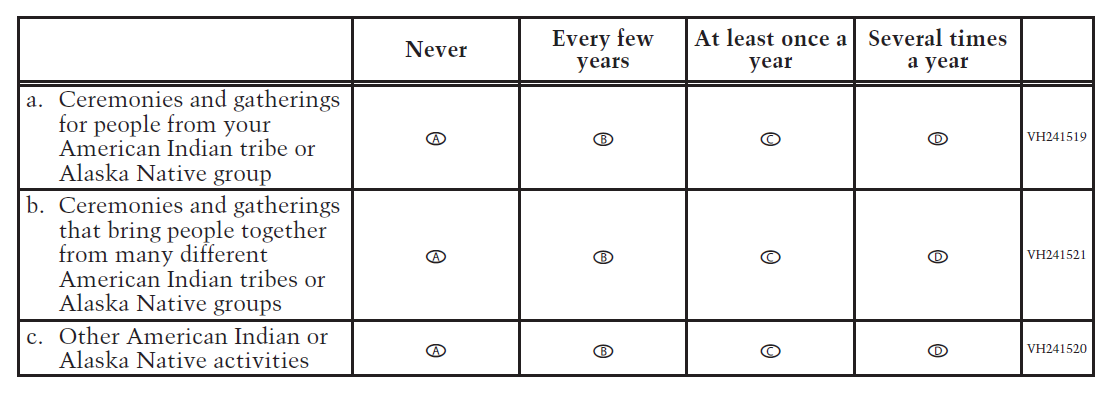
VH240133
6. How often do members of your family talk to each other in your American Indian
or Alaska Native language?
A Never or hardly ever
B Once or twice a month
C Once or twice a week
D Every day or almost every day
VH240134
7. How often do people in your school talk to each other in your American Indian or
Alaska Native language?
A Never or hardly ever
B Once or twice a month
C Once or twice a week
D Every day or almost every day
VH240135
8. How often do you attend classes in school that are taught in an American Indian or
Alaska Native language?
A My school does not offer classes that are taught in an American Indian or Alaska Native
language.
B Never or hardly ever
C Once or twice a month
D Once or twice a week
E Every day or almost every day
VH240136
9. How do you rate yourself in speaking an American Indian or Alaska Native
language?
A I cannot speak an American Indian or Alaska Native language.
B I can speak a few words or phrases.
C I can speak well.
VH240137
10. How do you rate yourself in reading an American Indian or Alaska Native
language?
A I cannot read in an American Indian or Alaska Native language.
B I can read a few words or phrases.
C I can read well.
VH240138
11. Who taught you most of what you know about an American Indian or Alaska
Native language?
A No one has taught me about an American Indian or Alaska Native language.
B Family members
C Friends
D Teachers
E Tribal representatives or elders
F Someone else (please specify):
VH240159
12. During 8th grade, how often have any of your teachers talked to your class about
the history, traditions, and cultures (ways of life, customs) of American Indian or
Alaska Native people?
A Never or hardly ever
B Once or twice a month
C Once or twice a week
D Every day or almost every day
VH241522
13. During 8th grade, have you attended any of the following activities organized by
your school? Select one answer choice on each row.

VH241527
14. During 8th grade, have you participated in any of the following activities organized
by your school? Select one answer choice on each row.
Yes No

VH240160
15. During 8th grade, have you used books, videos, or other materials (including
Internet resources) about American Indian or Alaska Native people in school?
A Yes, once or twice
B Yes, three or more times
C No
VH240161
16. During 8th grade, have you used books, videos, or other materials (including
Internet resources) about American Indian or Alaska Native people
outside of school?
A Yes, once or twice
B Yes, three or more times
C No
VH240142
17. In school, do you have access to a library, media center, or resource center with
books, videos, or other materials (including Internet resources) about American
Indian or Alaska Native people?
A Yes
B No
VH241533
18. Here are some sentences about reading. Fill in one oval on each line to show whether the
sentence describes a person like you.

VH241539
19. Here are some sentences about your school. Fill in one oval on each line to show whether the
sentence describes a person like you.

VH241544
20. How much do you agree with each of the following statements? Select one answer
choice on each row.

VH240156
21. How much do you like school?
A Not at all
B A little
C Somewhat
D Very much
VH240162
22. How much are the things you are learning in school preparing you for the life you
want to lead?
A Not at all
B A little
C A fair amount
D Very much
VH240163
23. During 8th grade, how often have you talked with any of your teachers outside of
regular class periods? For example, to get extra help with your assignments, to talk
about issues that matter to you, or just to visit.
A Never or hardly ever
B Once or twice a month
C Once or twice a week
D Every day or almost every day
VH240155
24. How often do you help other students from your school with their schoolwork?
For example, you might help other students to study for a test, help them with a
school project, or go over their homework with them.
A Never or hardly ever
B Once or twice a month
C Once or twice a week
D Every day or almost every day
VH241548
25. How often do any of the following people help you with your schoolwork? For
example, they might help you to study for a test, help you with a school project, or
go over your homework with you. Select one answer choice on each row.

VH241554
26. During 8th grade, how many times have you talked to each of the following people
about the classes you should take in high school or about what you want to do after
high school? Select one answer choice on each row.
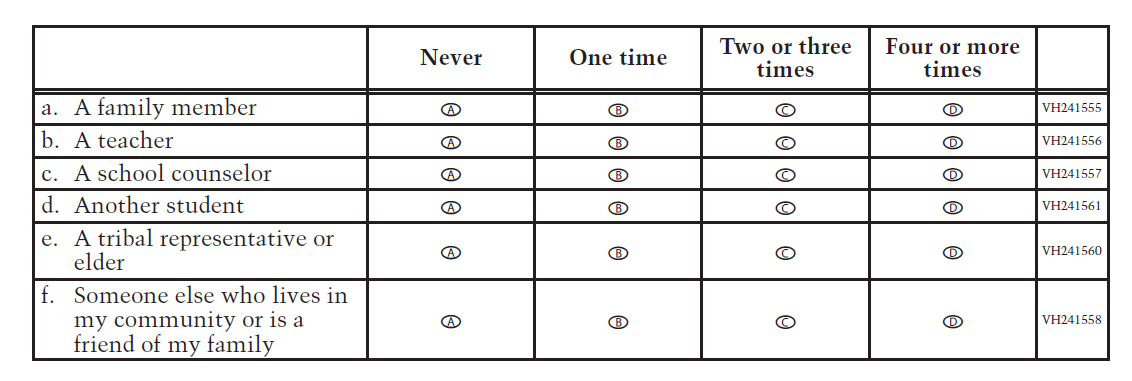
VH241562
27. Do you plan to do any of the following in your first year after high school? Select one
answer choice on each row.
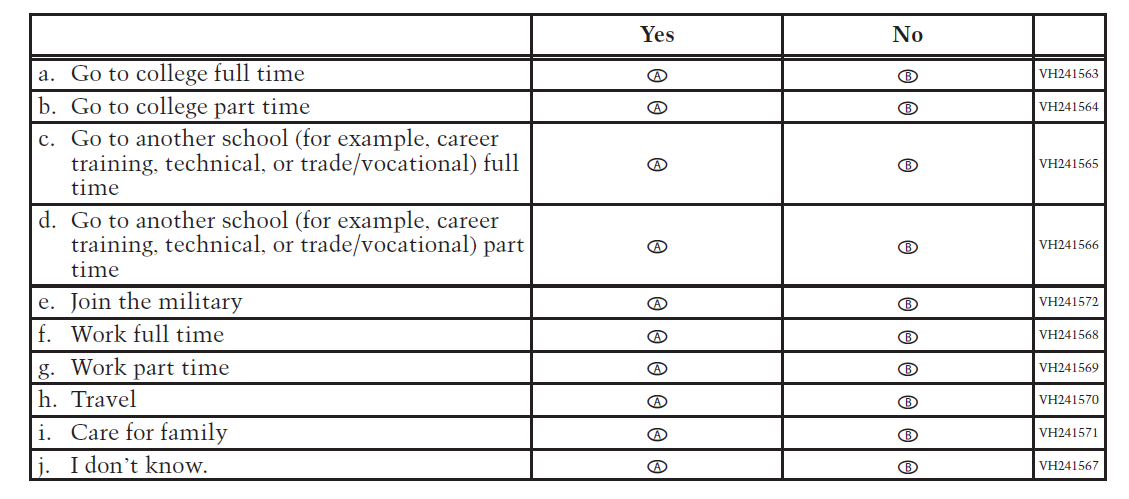
VH241573
28. To what extent is each of the following a problem in your school? Select one answer
choice on each row.

VH240157
29. Do you know the name of the American Indian tribe or Alaska Native group you
belong to or are enrolled in?
A Yes
B No
C I’m not sure.
VH242881
30. If you know the name of the American Indian tribe or Alaska Native group that
you belong to or are enrolled in, or if you think you know it, please print it on the
line below. Do not worry about spelling. If you belong to more than one American
Indian tribe or Alaska Native group, write the names of as many as you know.
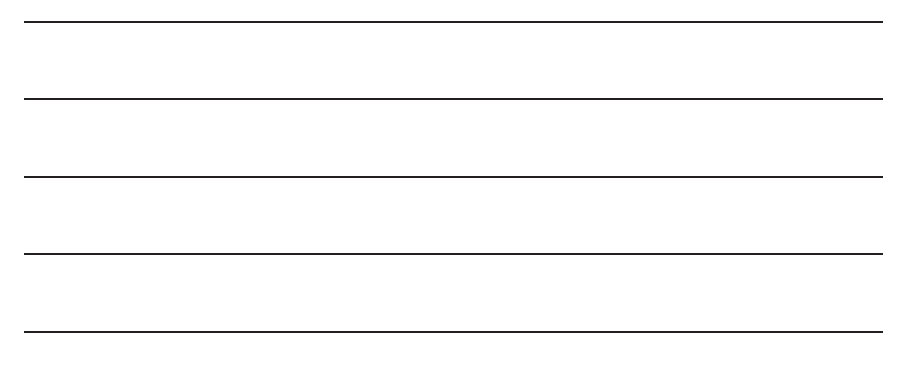
VH242882
31. What else would you like to say about yourself, your school, or about American
Indian or Alaska Native people? Use these lines to write your ideas.

Teacher Operational Grade 4 NIES
VH253874
1. Counting this year, how many years have you taught at this school? If less than 1
year total at this school, enter “01.”
 Years
Years
VH253877
2. How many students are currently in your class?
 Students
Students
VH241581
3. To what extent have you acquired knowledge, skills, and information specific to
teaching American Indian or Alaska Native students from each of the following
sources? Select one circle in each row.
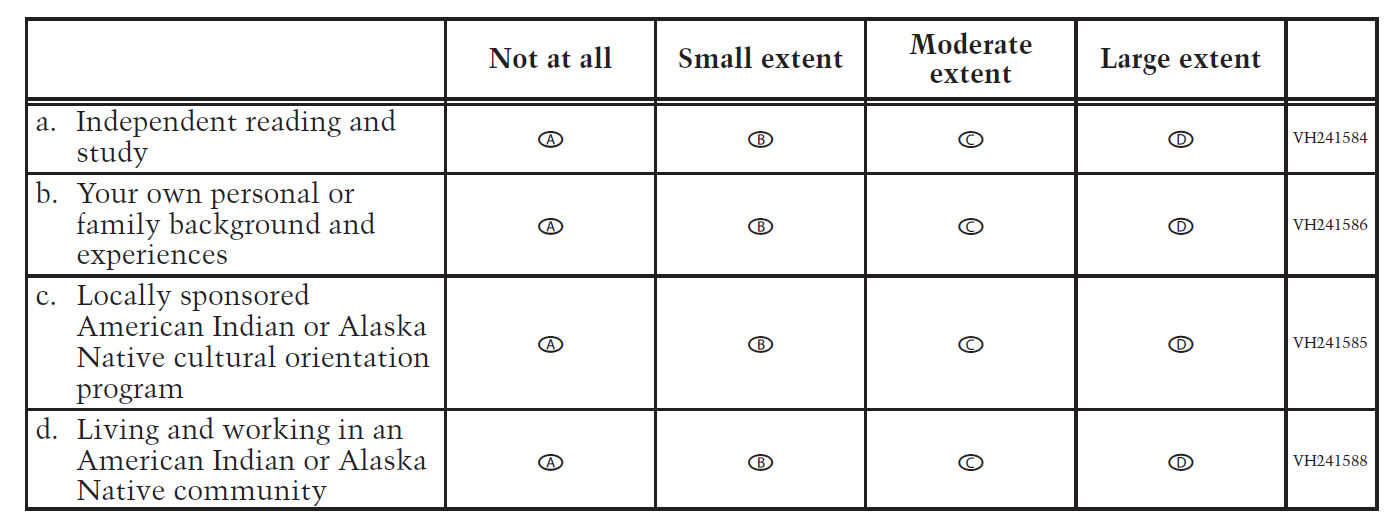
VH241590
4. To what extent have you acquired knowledge, skills, and information specific to
teaching American Indian or Alaska Native students from each of the following
types of classes? Select one circle in each row.

VH241593
5. During the last two years, how many times have you consulted each of the
following resources to help you improve the academic performance of your
American Indian or Alaska Native students? Select one circle in each row.

VH240164
6. During the last two years, to what extent have you implemented culturally
specific instructional practices for American Indian or Alaska Native students in
your classroom?
A Not at all
B Small extent
C Moderate extent
D Large extent
VH240165
7. During the last two years, how many times have you attended professional or
community-based development programs (such as in-service classes and
workshops, including online classes) aimed at developing culturally specific
instructional practices for American Indian or Alaska Native students?
A Never
B 1 or 2 times
C 3 or 4 times
D 5 or more times
VH240166
8. To what extent have you implemented lessons learned from these professional or
community-based development programs in your classroom?
A Not at all
B Small extent
C Moderate extent
D Large extent
VH240167
9. Who sponsored the professional or community-based development programs you
attended in the last two years? Select all squares that apply.
A State
B District
C Tribal education department
D Indian education professional associations
E College or university
F Other (please specify):
VH240168
10. To what extent do you speak any of the native languages spoken by American
Indian or Alaska Native students who attend this school? If you know more than
one of these languages, answer for the one you know best.
A No knowledge or skill; nonspeaker
B Minimal functional or communicative ability; ability to use some words or phrases
C Moderate communicative ability; can express some ideas and communicate in some
situations, but limited and cannot always express ideas
D Fluent nonnative speaker
E Fluent native speaker
VH240169
11. To what extent do you use your students’ American Indian or Alaska Native
language(s) when you teach any core subject (reading, mathematics, science, and
social studies)?
A Instruction is entirely in English.
B Instruction is primarily in English, but words or phrases from the students’ American Indian
or Alaska Native language(s) are included occasionally.
C Instruction is primarily in English, but words or phrases from the students’ American Indian
or Alaska Native language(s) are included frequently.
D Instruction is primarily in the students’ American Indian or Alaska Native language(s).
VH241599
12. Have you received any of the following forms of preparation for teaching students
whose first language is not English (sometimes called Limited English Proficiency
[LEP] students or English Language Learners [ELL])? Select one circle in each row.
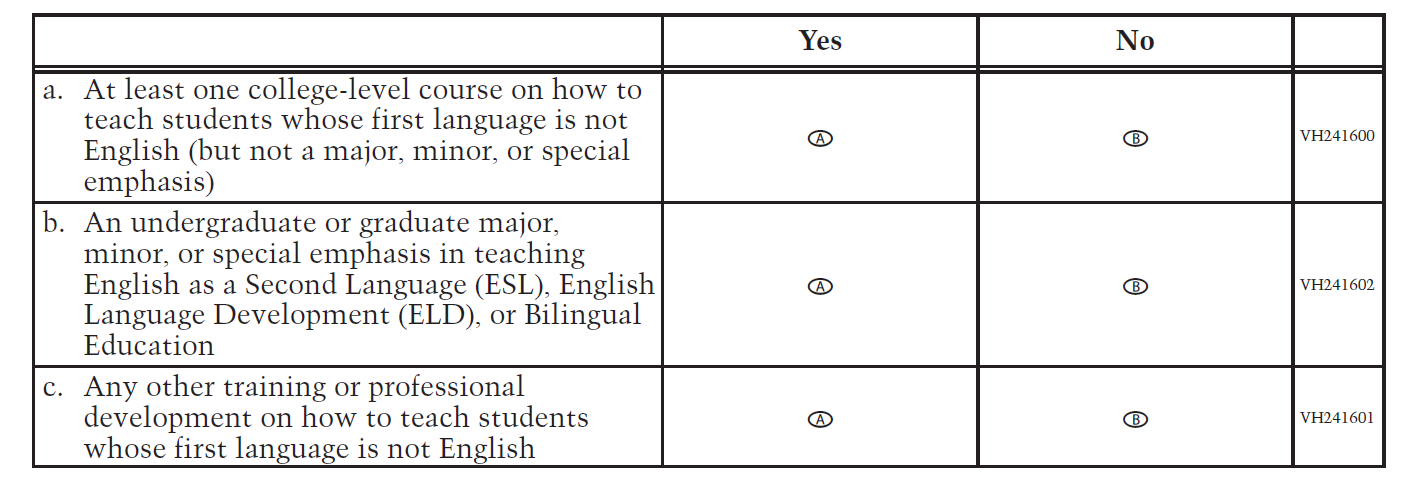
VH241603
13. To what extent do you use the following to assess the progress of your American
Indian or Alaska Native students? Select one circle in each row.
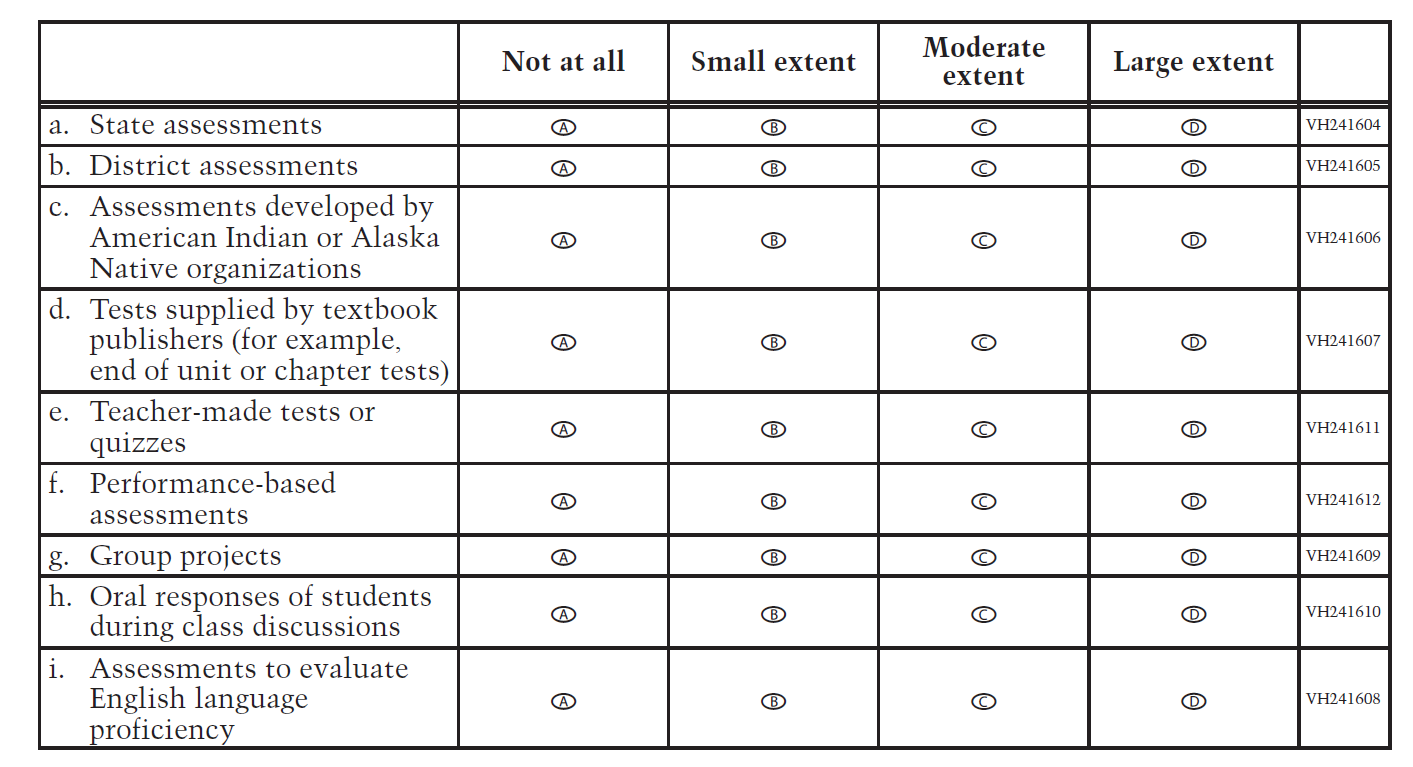
VH240170
14. Do you teach reading/language arts to grade 4 students?
A Yes
B No
VH241613
15. How often do you integrate materials about the following topics into your
reading/language arts lessons? Select one circle in each row.

VH241616
16. How often do you have your students do each of the following reading/language arts
activities? Select one circle in each row.
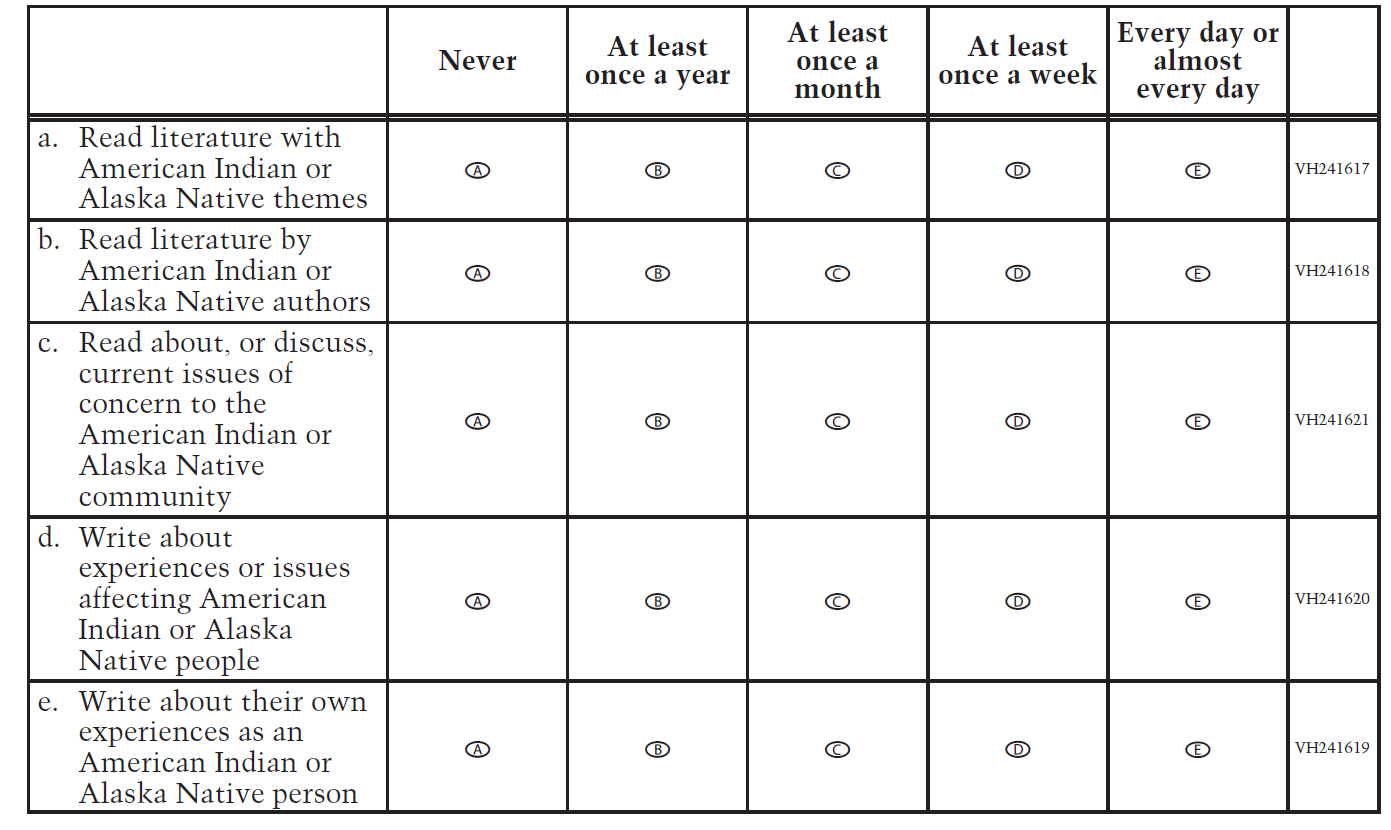
VH241622
17. How much do you rely on each of the following documents in planning
reading/language arts lessons? Select one circle in each row.
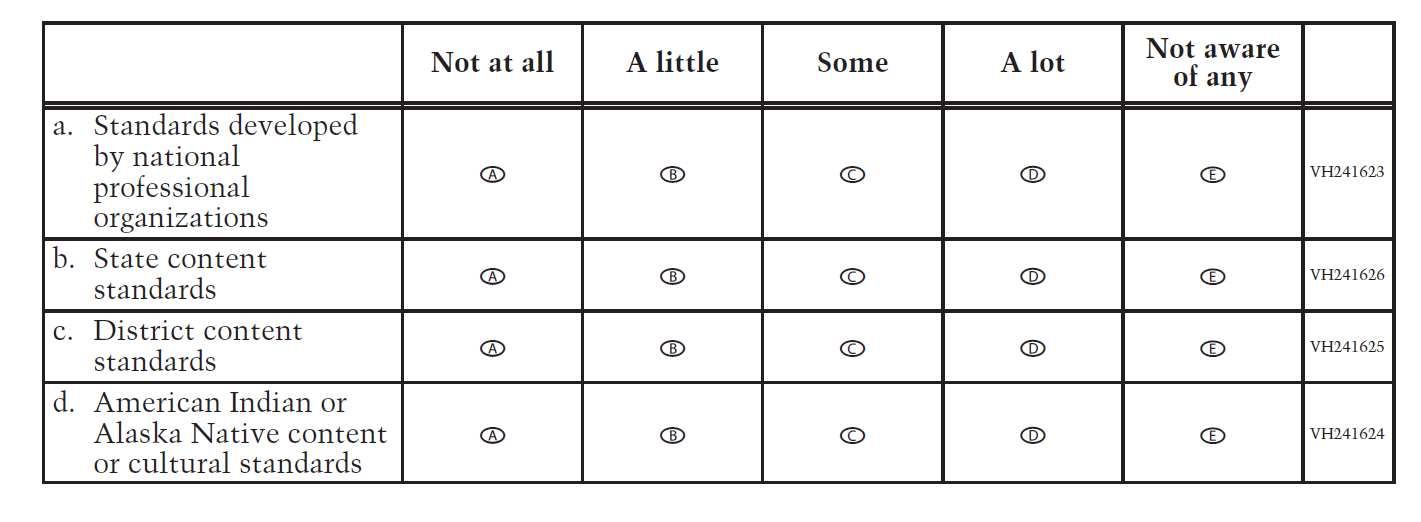
VH240171
18. Do you teach mathematics to grade 4 students?
A Yes
B No
VH241627
19. How often do you integrate materials about the following topics into your
mathematics lessons? Select one circle in each row.

VH241630
20. How often do you have your students do each of the following mathematics
activities? Select one circle in each row.
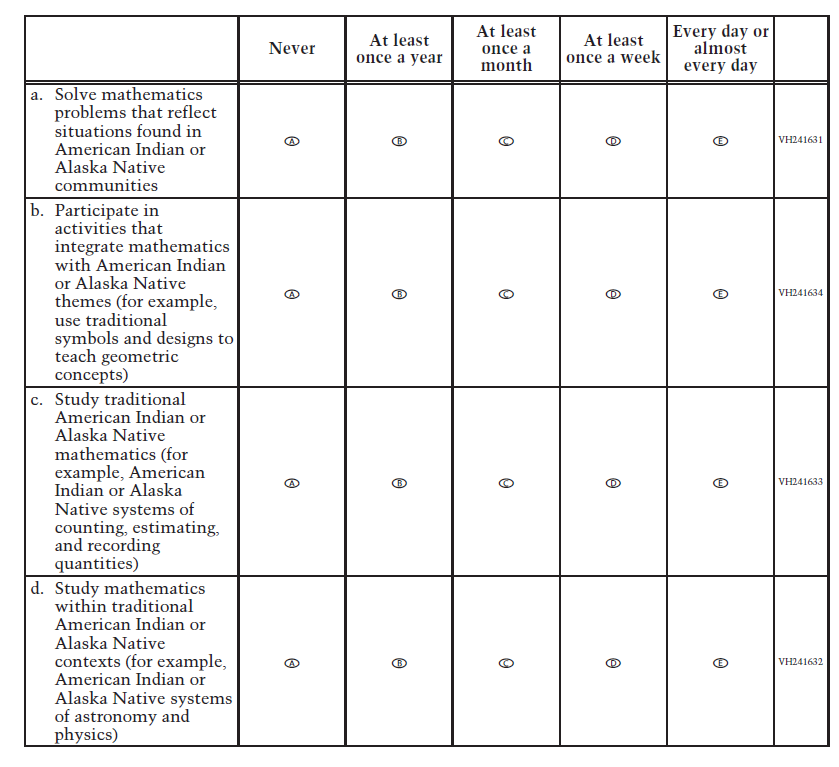
VH241635
21. How much do you rely on each of the following documents in planning
mathematics lessons? Select one circle in each row.
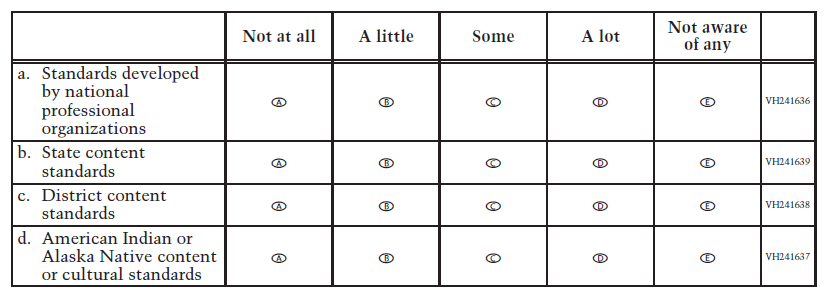
VH241640
22. How much do you agree with each of the following statements about the materials
available in your school library, media center, or resource center? Select one circle in
each row.
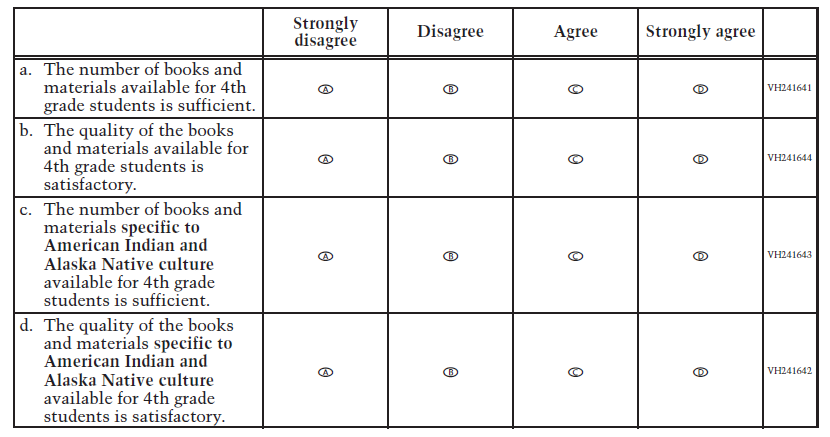
VH241645
23. To what extent is each of the following a problem in your school? Select one circle in
each row.
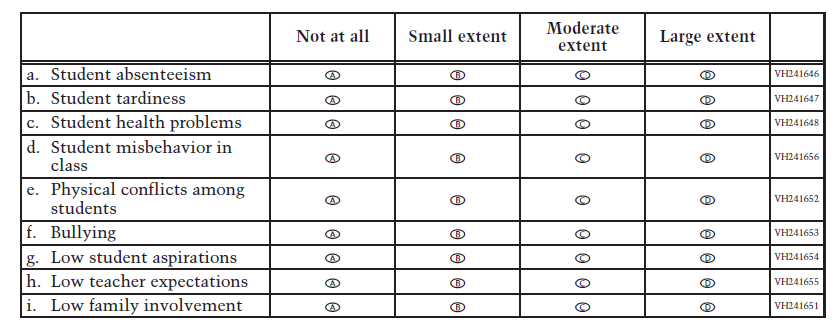
VH240385
24. Are you Hispanic or Latino? Select all squares that apply.
A No, I am not Hispanic or Latino.
B Yes, I am Mexican, Mexican American, or Chicano.
C Yes, I am Puerto Rican or Puerto Rican American.
D Yes, I am Cuban or Cuban American.
E Yes, I am from some other Hispanic or Latino background.
VH240378
25. Which of the following best describes you? Select all squares that apply.
A White
B Black or African American
C Asian
D American Indian or Alaska Native (Print the name of your American Indian tribe or Alaska
Native group below. You may indicate more than one tribe or group.)
E Native Hawaiian or other Pacific Islander
VH242885
26. What have you found to be the most effective teaching and learning strategies for
increasing the achievement of your American Indian or Alaska Native students?

VH242886
27. In the space below, please share with us your thoughts about any other important
issue(s) about your students, school, or community that are related to student
academic performance, student aspirations, or other educational matters.

Teacher Operational Grade 8 NIES
VH253874
1. Counting this year, how many years have you taught at this school? If less than 1
year total at this school, enter “01.”
![]() Years
Years
VH241581
2. To what extent have you acquired knowledge, skills, and information specific to
teaching American Indian or Alaska Native students from each of the following
sources? Select one circle in each row.
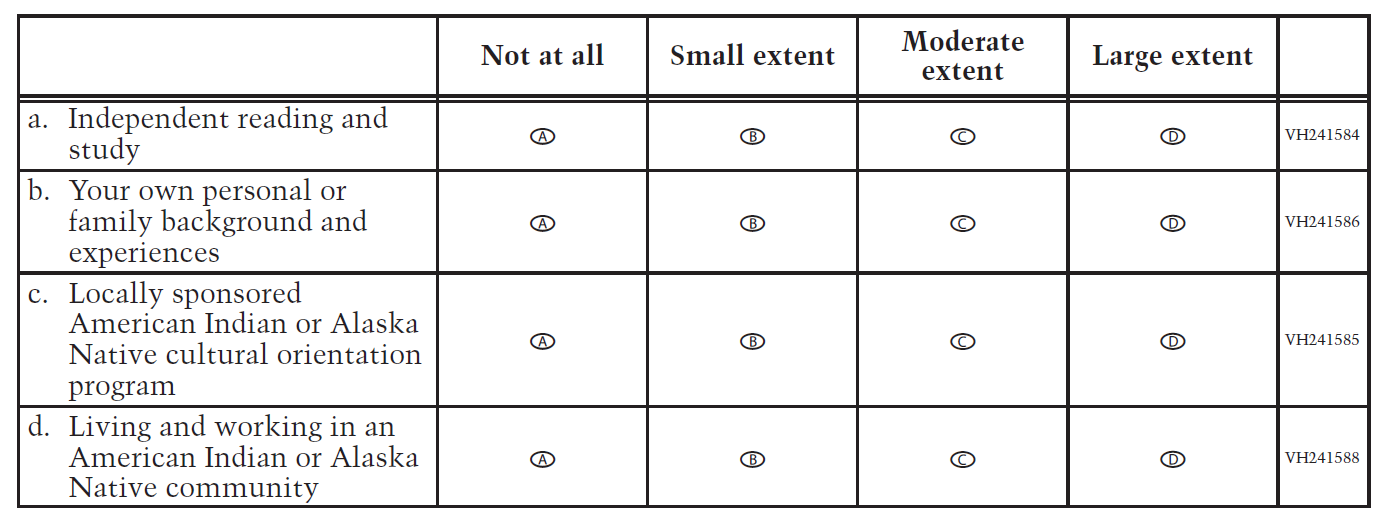
VH241590
3. To what extent have you acquired knowledge, skills, and information specific to
teaching American Indian or Alaska Native students from each of the following
types of classes? Select one circle in each row.

VH241593
4. During the last two years, how many times have you consulted each of the
following resources to help you improve the academic performance of your
American Indian or Alaska Native students? Select one circle in each row.

VH240164
5. During the last two years, to what extent have you implemented culturally
specific instructional practices for American Indian or Alaska Native students in
your classroom?
A Not at all
B Small extent
C Moderate extent
D Large extent
VH240165
6. During the last two years, how many times have you attended professional or
community-based development programs (such as in-service classes and
workshops, including online classes) aimed at developing culturally specific
instructional practices for American Indian or Alaska Native students?
A Never
B 1 or 2 times
C 3 or 4 times
D 5 or more times
VH240166
7. To what extent have you implemented lessons learned from these professional or
community-based development programs in your classroom?
A Not at all
B Small extent
C Moderate extent
D Large extent
VH240167
8. Who sponsored the professional or community-based development programs you
attended in the last two years? Select all squares that apply.
A State
B District
C Tribal education department
D Indian education professional associations
E College or university
F Other (please specify):
VH240168
9. To what extent do you speak any of the native languages spoken by American
Indian or Alaska Native students who attend this school? If you know more than
one of these languages, answer for the one you know best.
A No knowledge or skill; nonspeaker
B Minimal functional or communicative ability; ability to use some words or phrases
C Moderate communicative ability; can express some ideas and communicate in some
situations, but limited and cannot always express ideas
D Fluent nonnative speaker
E Fluent native speaker
VH241599
10. Have you received any of the following forms of preparation for teaching students
whose first language is not English (sometimes called Limited English Proficiency
[LEP] students or English Language Learners [ELL])? Select one circle in each row.
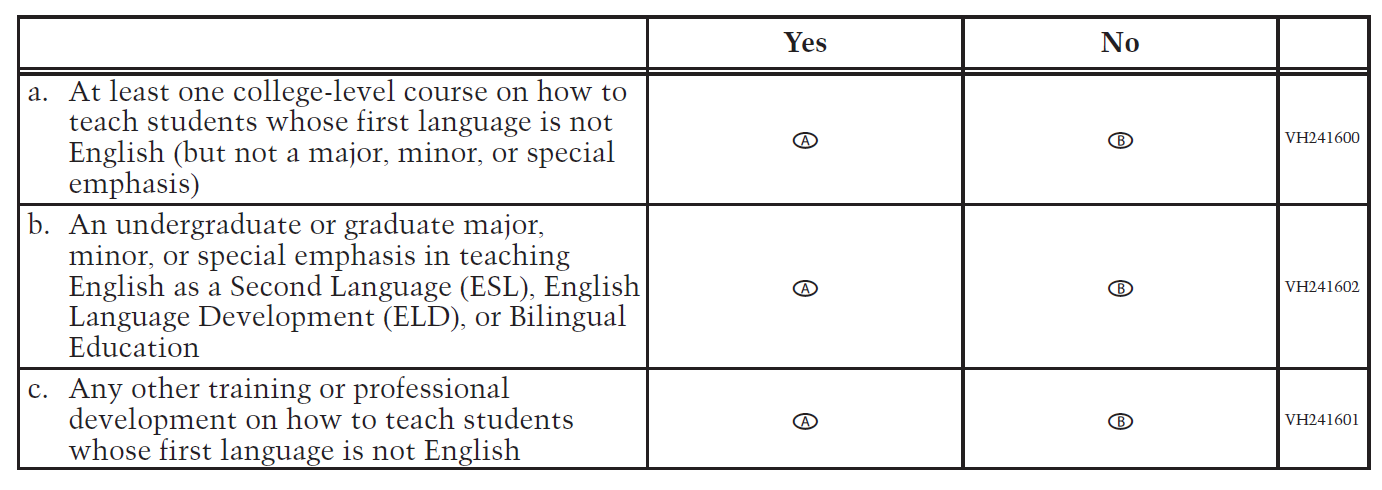
VH241603
11. To what extent do you use the following to assess the progress of your American
Indian or Alaska Native students? Select one circle in each row.
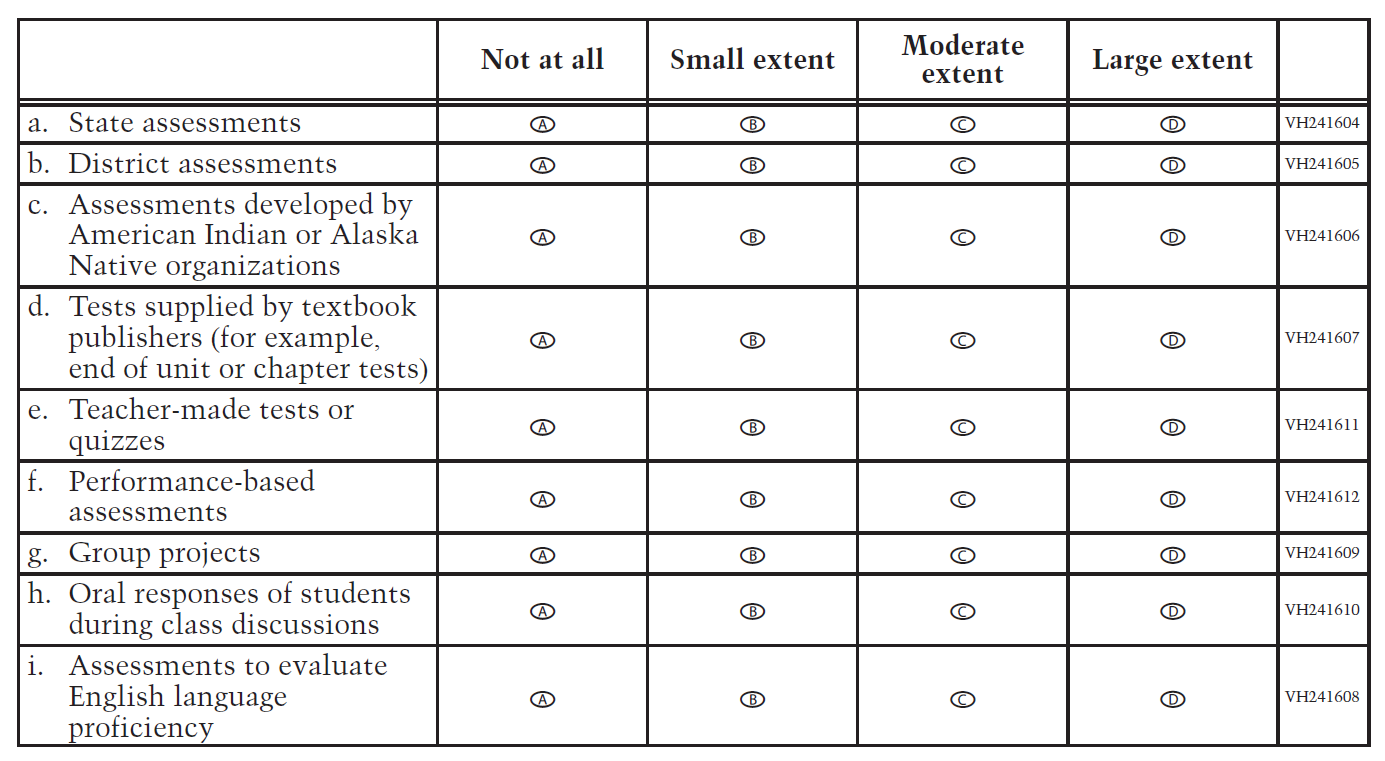
VH240172
12. Do you teach reading/language arts to grade 8 students?
A Yes
B No
VH240173
13. How many students are American Indian or Alaska Native in your
reading/language arts class? (Include both enrolled tribal members and descendants
in your calculations.)
A Few (less than 5)
B Several, but less than half the class
C At least half the class, but not every student
D The whole class
E I don’t know.
VH240174
14. To what extent do you use your students’ American Indian or Alaska Native
language(s) when you teach reading/language arts?
A Instruction is entirely in English.
B Instruction is primarily in English, but words or phrases from the students’ American Indian
or Alaska Native language(s) are included occasionally.
C Instruction is primarily in English, but words or phrases from the students’ American Indian
or Alaska Native language(s) are included frequently.
D Instruction is primarily in the students’ American Indian or Alaska Native language(s).
VH241613
15. How often do you integrate materials about the following topics into your
reading/language arts lessons? Select one circle in each row.

VH241616
16. How often do you have your students do each of the following reading/language arts
activities? Select one circle in each row.
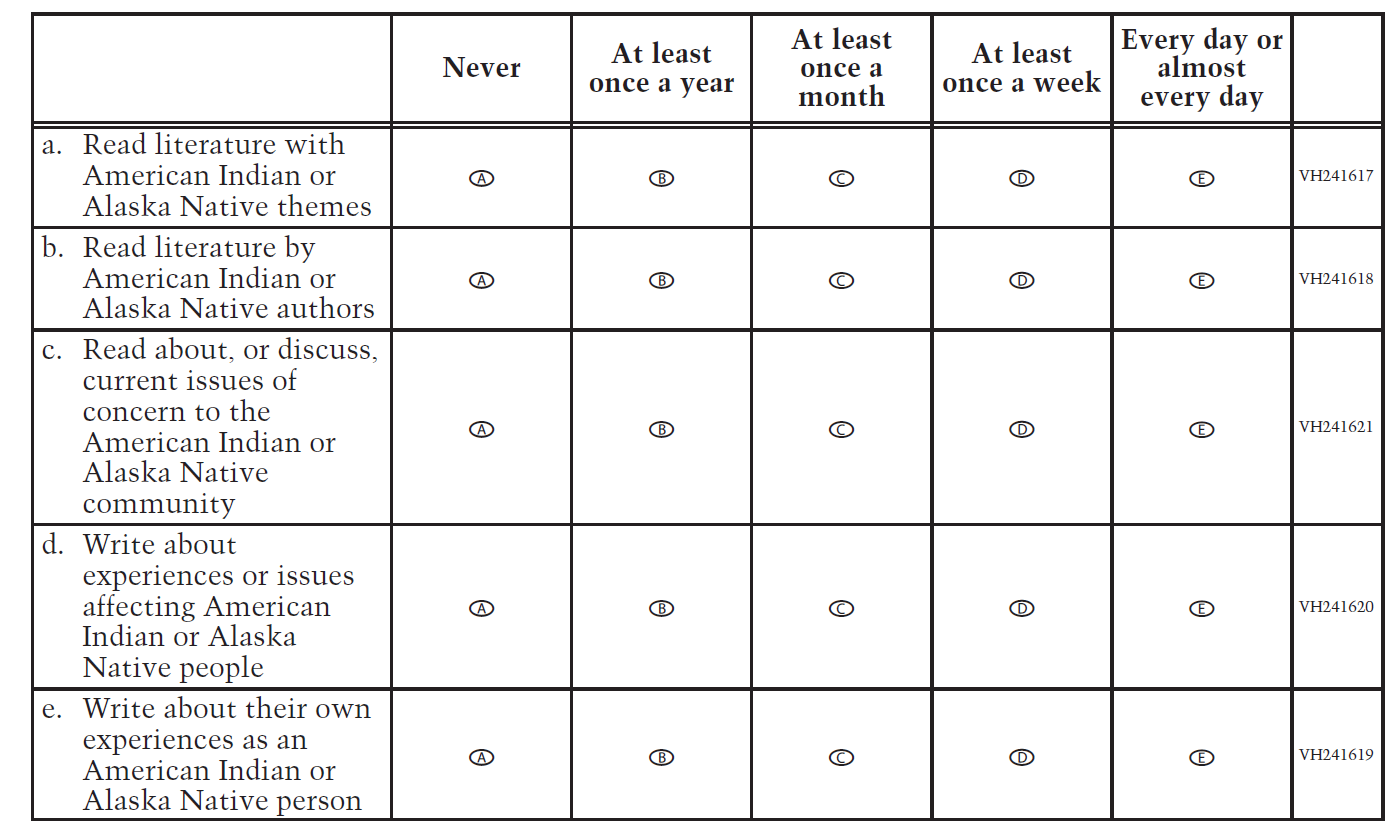
VH241622
17. How much do you rely on each of the following documents in planning
reading/language arts lessons? Select one circle in each row.
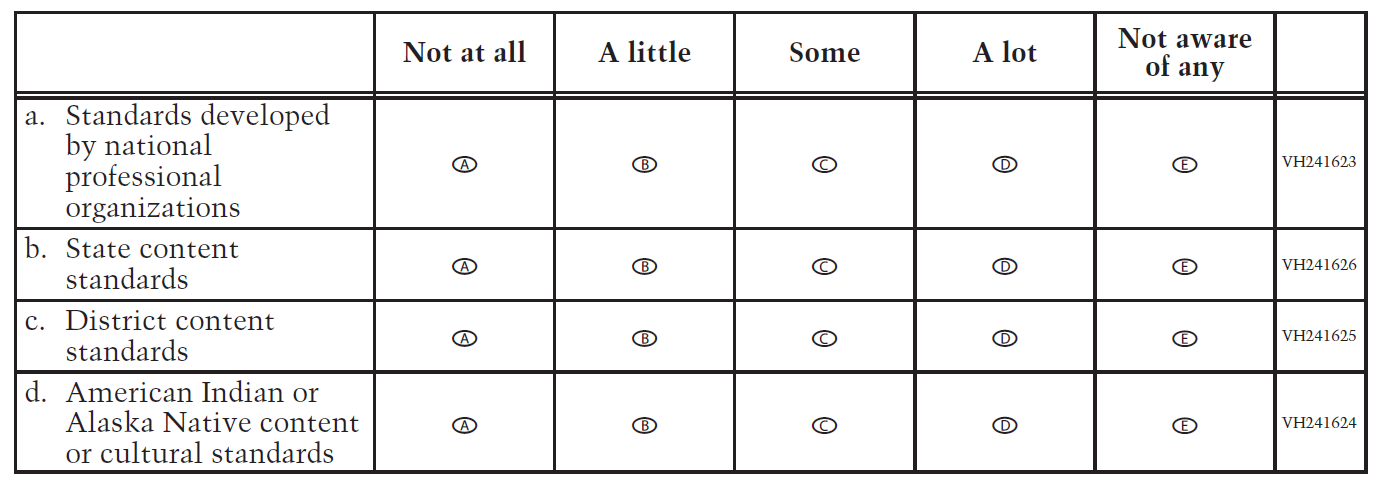
VH240175
18. Do you teach mathematics to grade 8 students?
A Yes
B No
VH240176
19. How many students are American Indian or Alaska Native in your mathematics
class? (Include both enrolled tribal members and descendants in your calculations.)
A Few (less than 5)
B Several, but less than half the class
C At least half the class, but not every student
D The whole class
E I don’t know.
VH240177
20. To what extent do you use your students’ American Indian or Alaska Native
language(s) when you teach mathematics?
A Instruction is entirely in English.
B Instruction is primarily in English, but words or phrases from the students’ American Indian
or Alaska Native language(s) are included occasionally.
C Instruction is primarily in English, but words or phrases from the students’ American Indian
or Alaska Native language(s) are included frequently.
D Instruction is primarily in the students’ American Indian or Alaska Native language(s).
VH241627
21. How often do you integrate materials about the following topics into your
mathematics lessons? Select one circle in each row.

VH241630
22. How often do you have your students do each of the following mathematics
activities? Select one circle in each row.
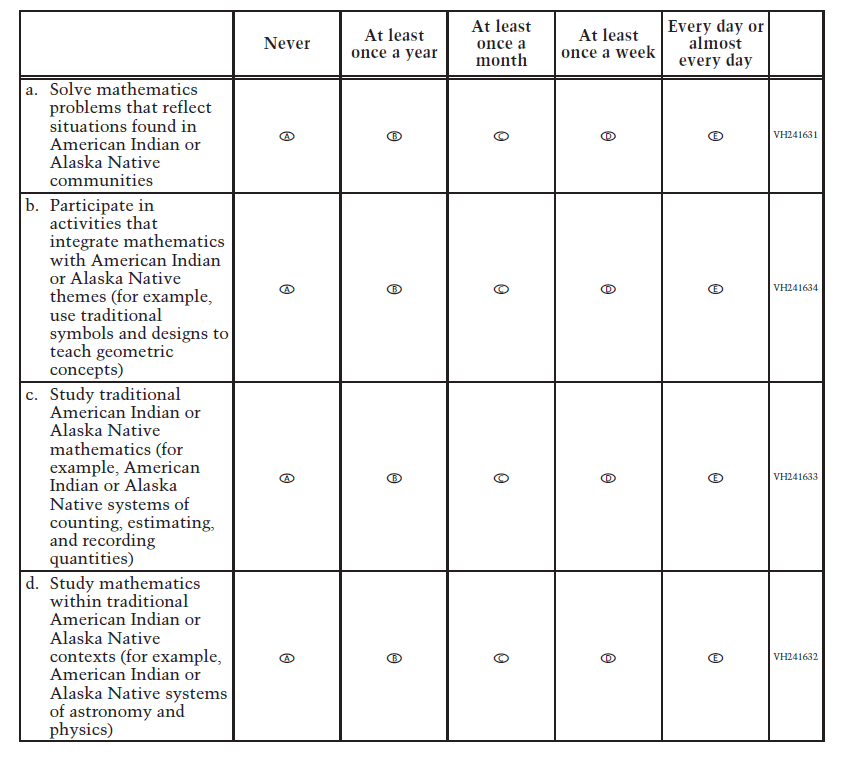
VH241635
23. How much do you rely on each of the following documents in planning
mathematics lessons? Select one circle in each row.
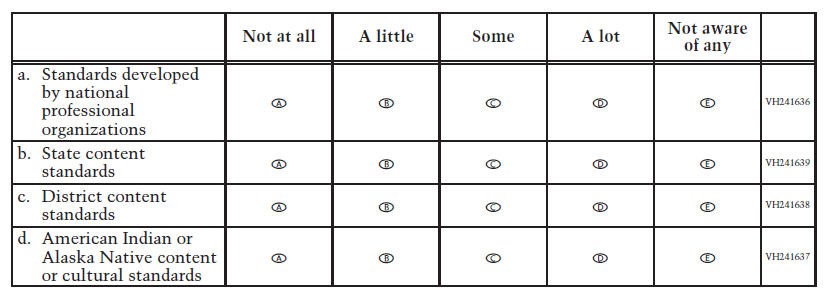
VH241657
24. How much do you agree with each of the following statements about the materials
available in your school library, media center, or resource center? Select one circle in
each row.
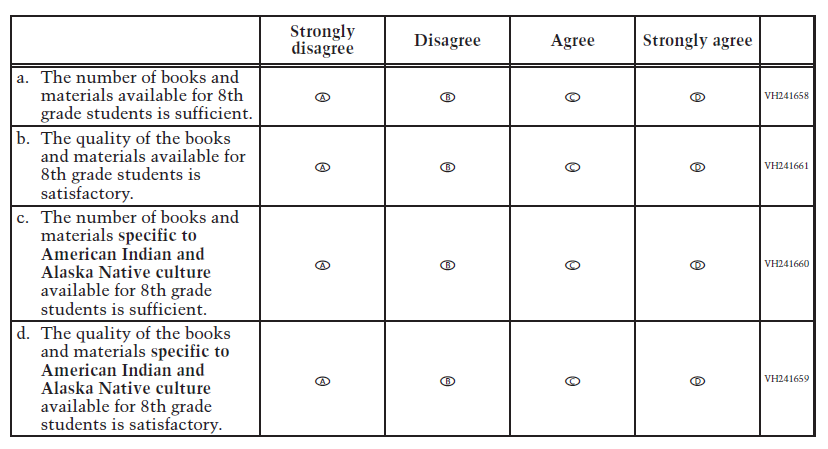
VH240178
25. About how many of your grade 8 students will complete the 8th grade?
A None
B A few
C Some
D Most
E All
F I don’t know.
VH240179
26. About how many of your grade 8 students will be prepared for high school?
A None
B A few
C Some
D Most
E All
F I don’t know.
VH241645
27. To what extent is each of the following a problem in your school? Select one circle in
each row.
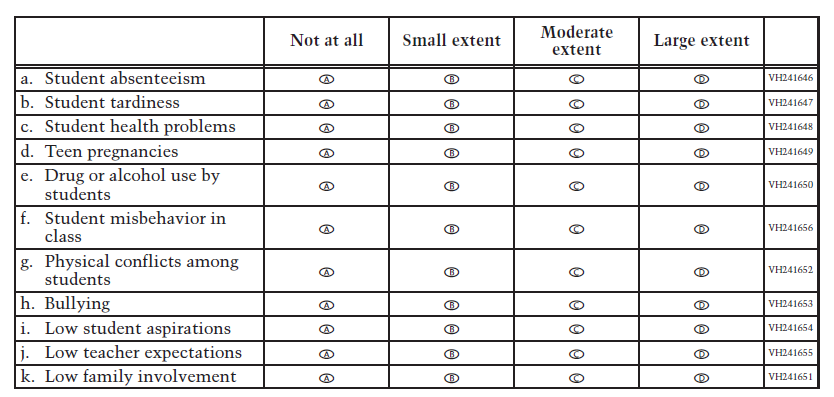
VH240385
28. Are you Hispanic or Latino? Select all squares that apply.
A No, I am not Hispanic or Latino.
B Yes, I am Mexican, Mexican American, or Chicano.
C Yes, I am Puerto Rican or Puerto Rican American.
D Yes, I am Cuban or Cuban American.
E Yes, I am from some other Hispanic or Latino background.
VH240378
29. Which of the following best describes you? Select all squares that apply.
A White
B Black or African American
C Asian
D American Indian or Alaska Native (Print the name of your American Indian tribe or Alaska
Native group below. You may indicate more than one tribe or group.)
E Native Hawaiian or other Pacific Islander
VH242885
30. What have you found to be the most effective teaching and learning strategies for
increasing the achievement of your American Indian or Alaska Native students?

VH242886
31. In the space below, please share with us your thoughts about any other important
issue(s) about your students, school, or community that are related to student
academic performance, student aspirations, or other educational matters.

School Operational Grade 4 NIES
VH242887
1. What is your professional position (title) at this school?

VH253882
2. Counting this year, how many years has the current principal or head of school
held his/her position at this school? If less than 1 year total, enter “01.”
![]() Years
Years
VH240180
3. Which of the following describes your school best? Please select one circle only.
A Regular public school
B Charter public school
C Bureau of Indian Education contracted or grant school
D Bureau of Indian Education operated school
E Other nonpublic school
VH240181
4. Is your school a boarding school?
A Yes
B No
VH240182
5. Is your school located on a reservation/on tribal land?
A Yes
B No
VH240183
6. Is your school an American Indian or Alaska Native language immersion school?
A Yes
B No
VH253888
7. How many American Indian and/or Alaska Native students are enrolled at your
school? (Include both enrolled tribal members and descendants in your
calculations.)
![]()
![]() Students
Students
VH241662
8. For this school year, has funding from any of the following sources been used to
provide educational services and support for American Indian or Alaska Native
students? Some of the sources are designated specifically for American Indian or
Alaska Native education, while others are intended for broader use. Select one circle in
each row.
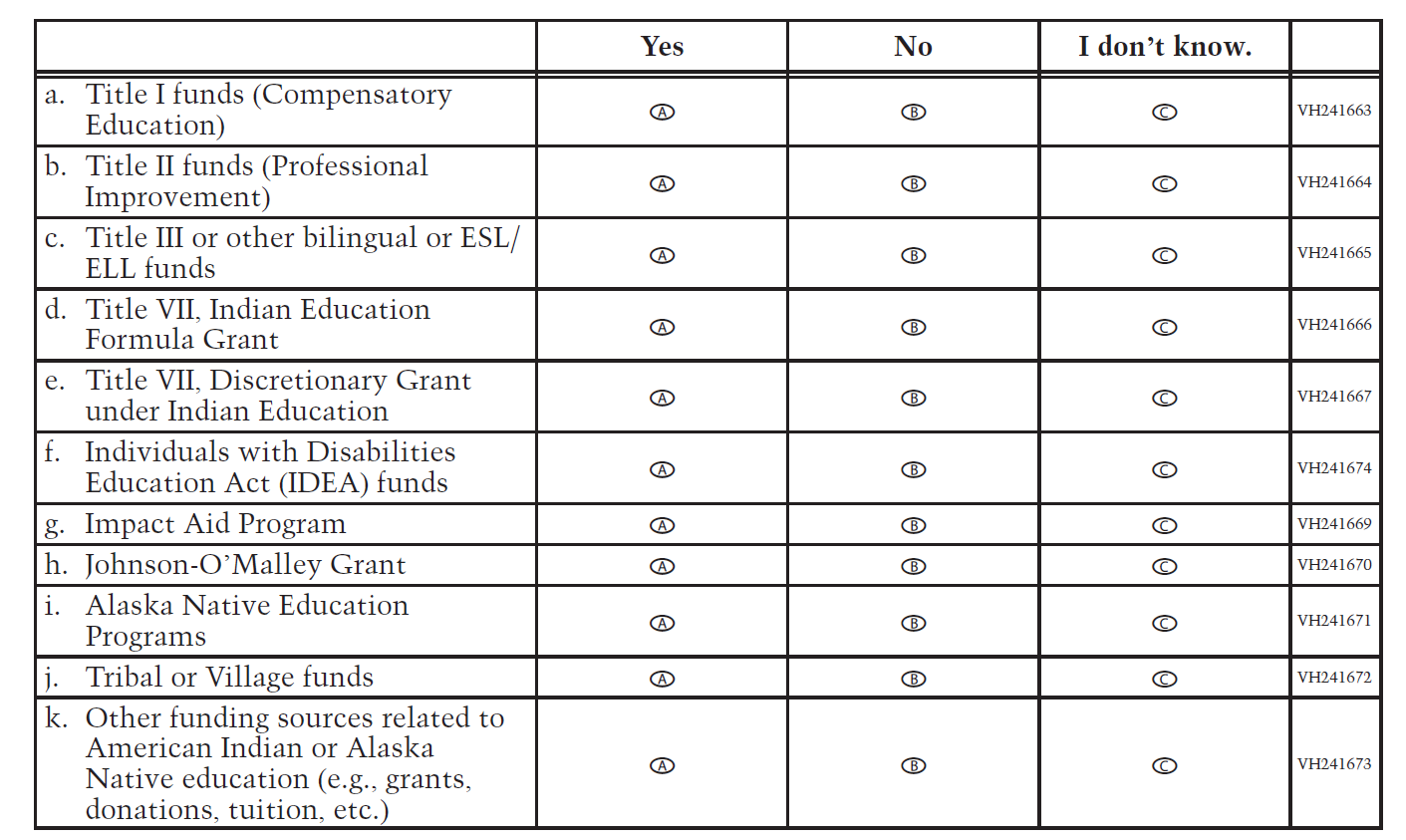
VH241675
9. Are families of your students involved with your school in the following ways? Select
one circle in each row.
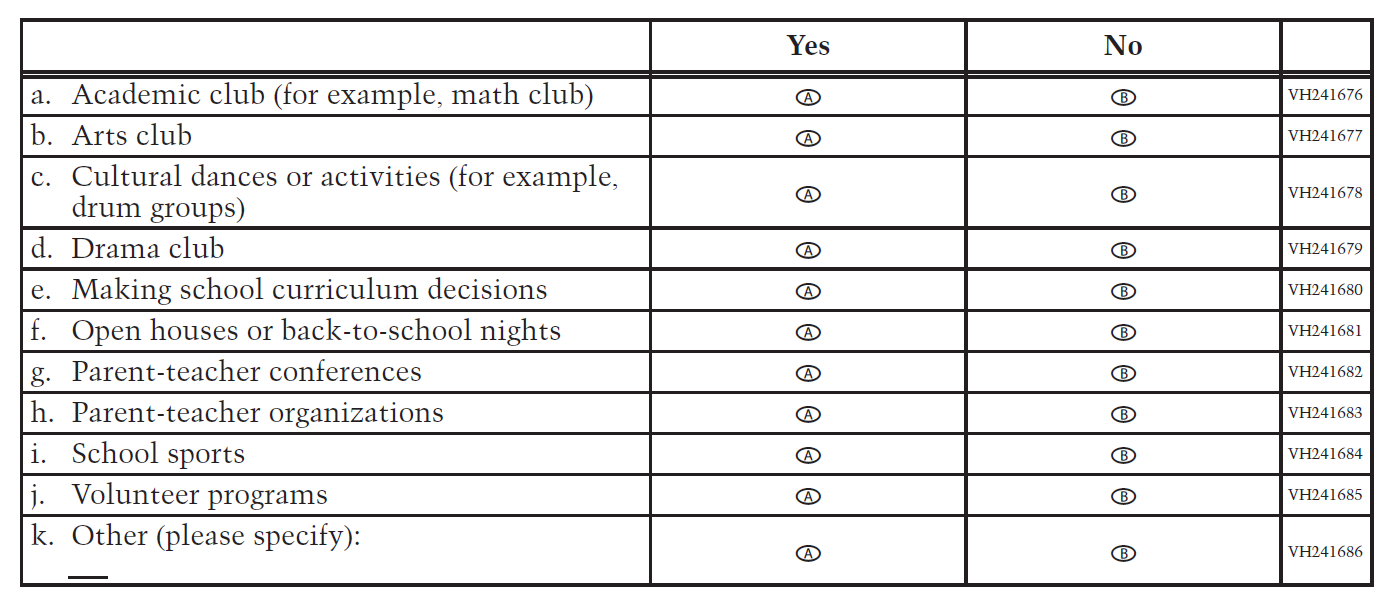
VH241687
10. In a typical school year, how many times has a member of the American Indian or
Alaska Native community done the following? Select one circle in each row.

VH241691
11. Are the following courses and programs about American Indian or Alaska Native
traditions and culture offered at your school each year? Select one circle in each row.

VH241697
12. Are the following courses or programs about American Indian or Alaska Native
traditions and culture required or elective for students at your school? Select one circle
in each row.

VH241701
13. Do students in your school receive instruction about American Indian or Alaska
Native cultures in any of the following areas? Select one circle in each row.

VH241709
14. How much influence does each of the following standards have on your school’s
reading/language arts curriculum? Select one circle in each row.
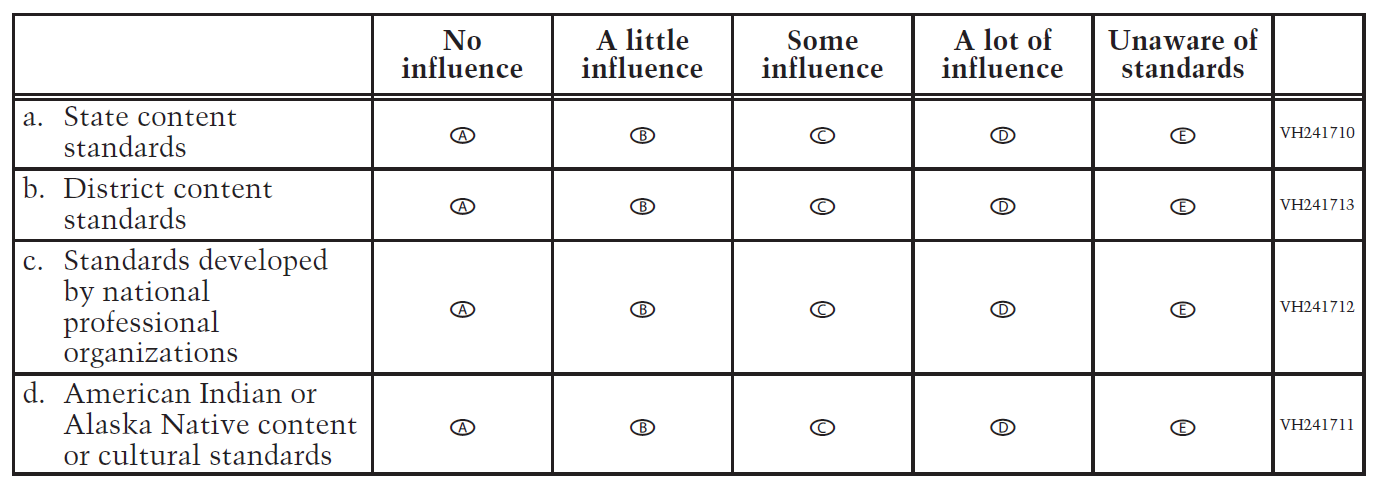
VH241714
15. How much influence does each of the following standards have on your school’s
mathematics curriculum? Select one circle in each row.
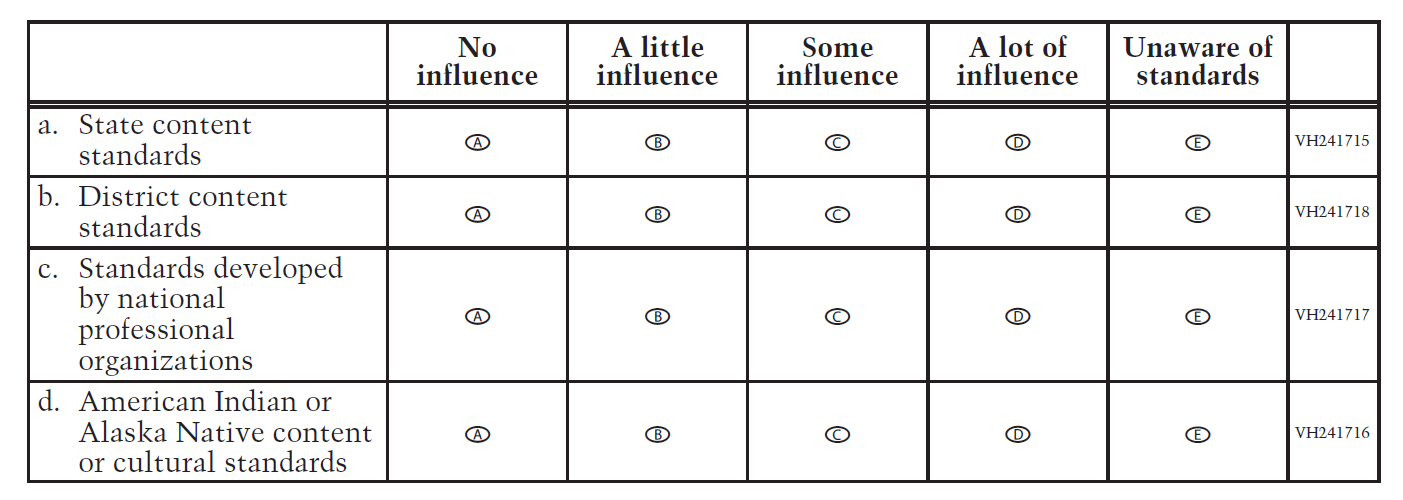
VH241719
16. Considering all of the students in your school, to what extent is each of the
following a problem? Select one circle in each row.
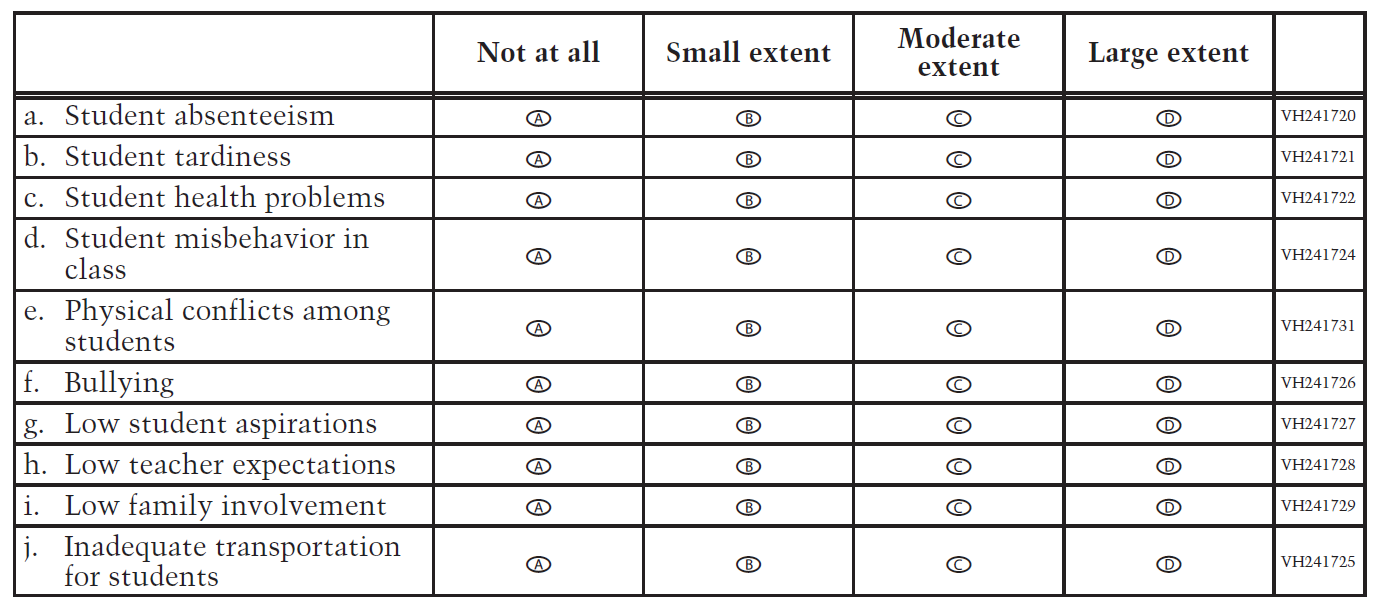
VH241732
17. Which of the following types of student and family services are offered at your
school on a regular basis? Select one circle in each row.

VH241740
18. In a typical school year, how often does your school provide each of the following
opportunities for communication between school and families? Select one circle in
each row.
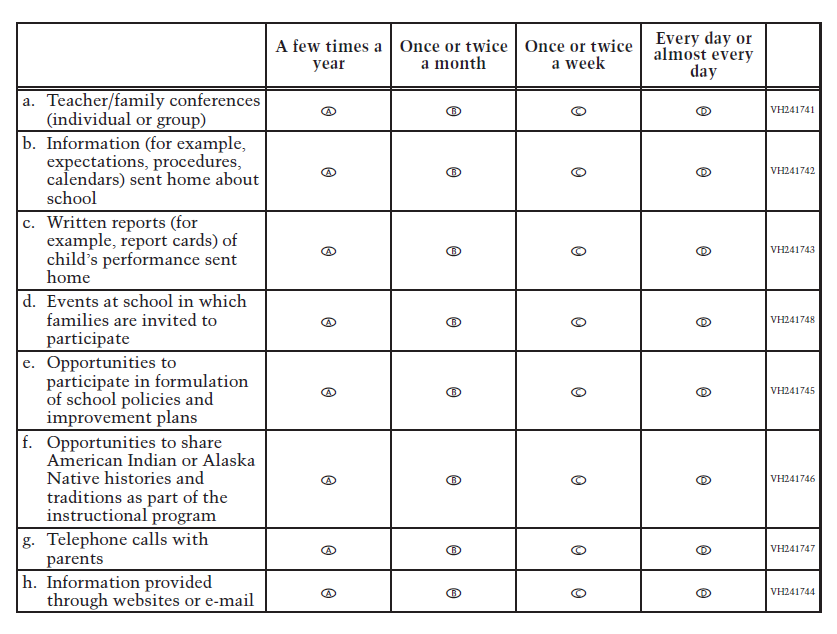
VH241749
19. Please indicate what percentage of the individuals at your school is described by
each of the following statements: Select one circle in each row.
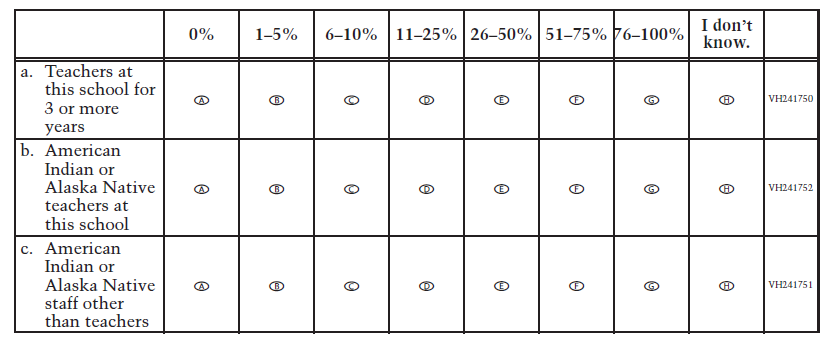
School Operational Grade 8 NIES
VH242887
What is your professional position (title) at this school?

VH253882
2. Counting this year, how many years has the current principal or head of school
held his/her position at this school? If less than 1 year total, enter “01.”
![]() Years
Years
VH240180
3. Which of the following describes your school best? Please select one circle only.
A Regular public school
B Charter public school
C Bureau of Indian Education contracted or grant school
D Bureau of Indian Education operated school
E Other nonpublic school
VH240181
4. Is your school a boarding school?
A Yes
B No
VH240182
5. Is your school located on a reservation/on tribal land?
A Yes
B No
VH240183
6. Is your school an American Indian or Alaska Native language immersion school?
A Yes
B No
VH253888
7. How many American Indian and/or Alaska Native students are enrolled at your
school? (Include both enrolled tribal members and descendants in your
calculations.)

 Students
Students
VH241662
8. For this school year, has funding from any of the following sources been used to
provide educational services and support for American Indian or Alaska Native
students? Some of the sources are designated specifically for American Indian or
Alaska Native education, while others are intended for broader use. Select one circle in
each row.
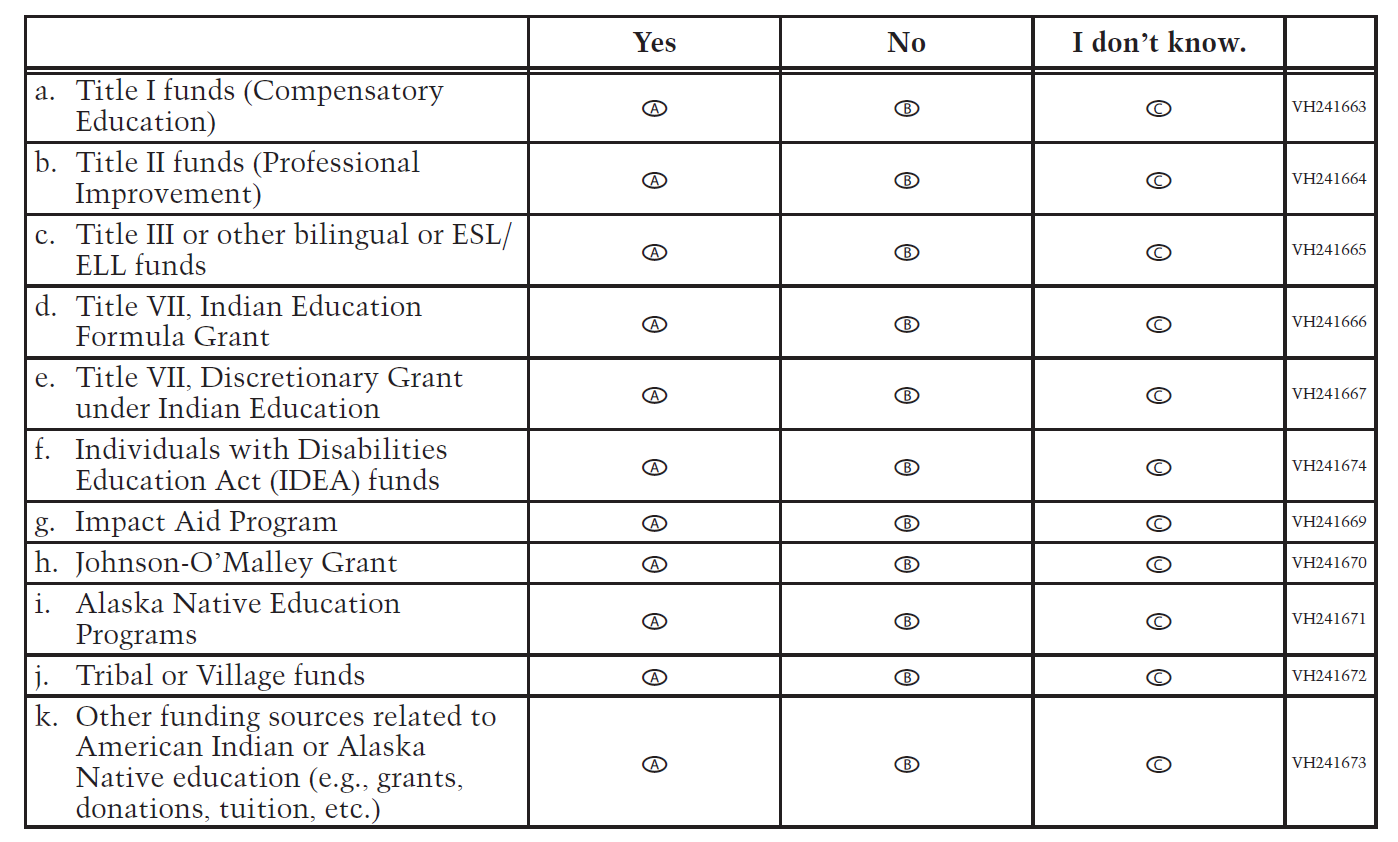
VH241675
9. Are families of your students involved with your school in the following ways? Select
one circle in each row.
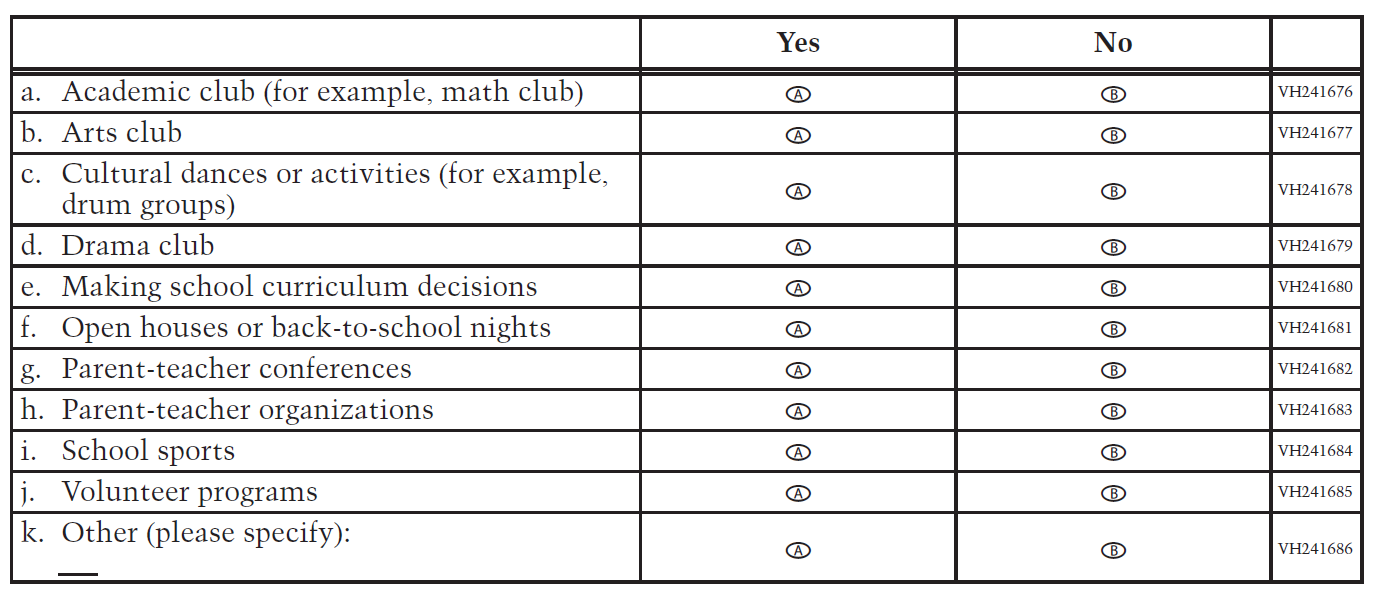
VH241687
10. In a typical school year, how many times has a member of the American Indian or
Alaska Native community done the following? Select one circle in each row.
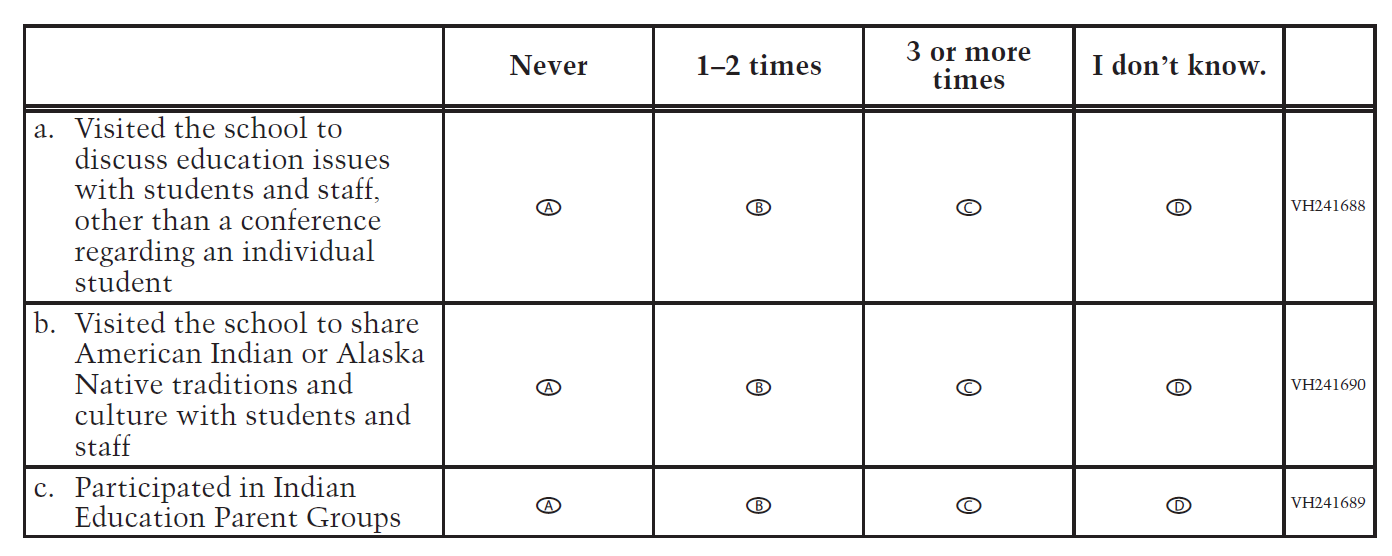
VH241691
11. Are the following courses and programs about American Indian or Alaska Native
traditions and culture offered at your school each year? Select one circle in each row.

VH241697
12. Are the following courses or programs about American Indian or Alaska Native
traditions and culture required or elective for students at your school? Select one circle
in each row.

VH241701
13. Do students in your school receive instruction about American Indian or Alaska
Native cultures in any of the following areas? Select one circle in each row.

H241709
14. How much influence does each of the following standards have on your school’s
reading/language arts curriculum? Select one circle in each row.
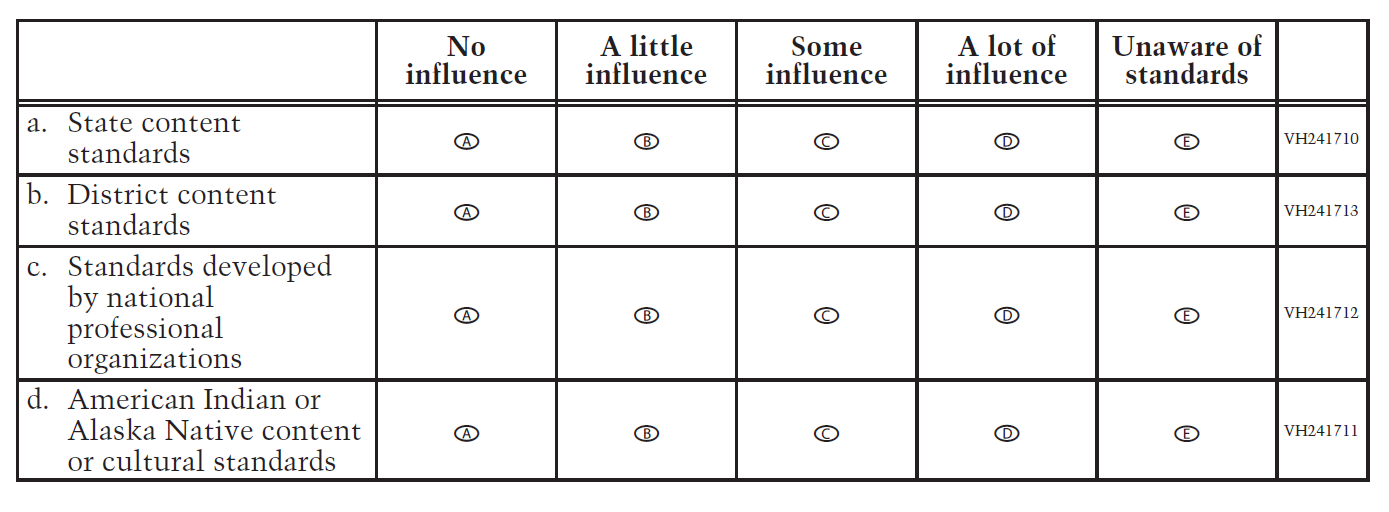
VH241714
15. How much influence does each of the following standards have on your school’s
mathematics curriculum? Select one circle in each row.
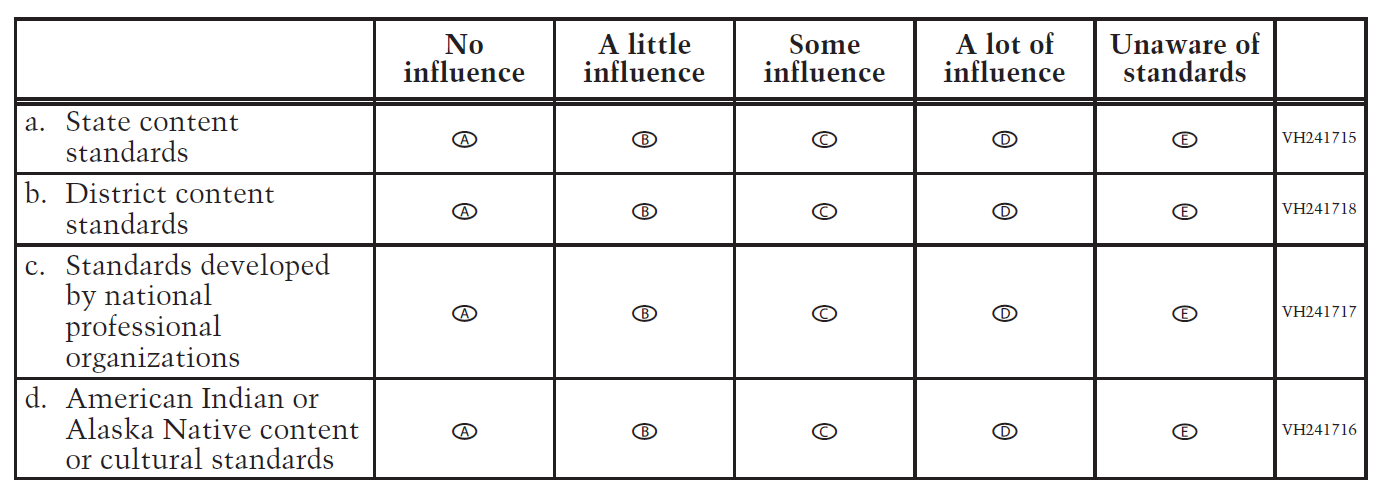
VH241719
16. Considering all of the students in your school, to what extent is each of the
following a problem? Select one circle in each row.
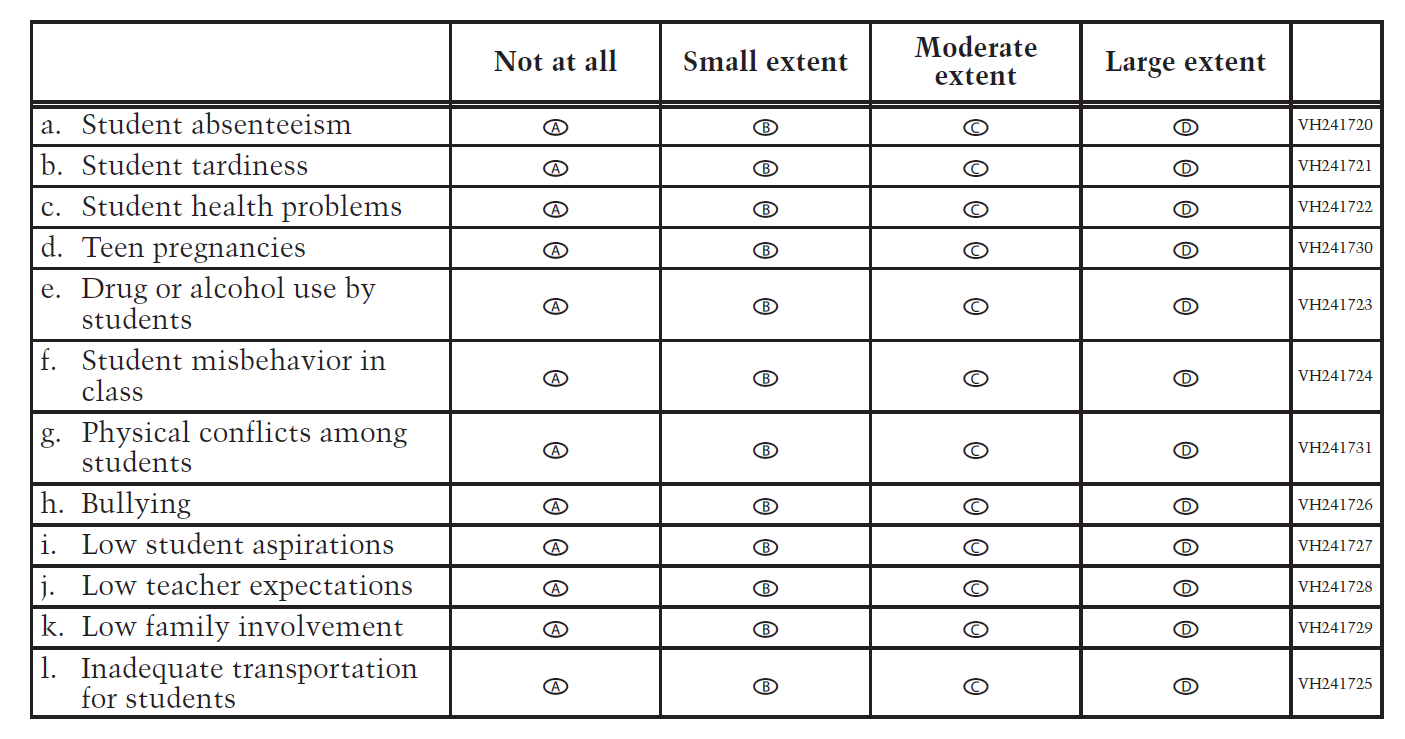
VH241732
17. Which of the following types of student and family services are offered at your
school on a regular basis? Select one circle in each row.

VH241740
18. In a typical school year, how often does your school provide each of the following
opportunities for communication between school and families? Select one circle in
each row.
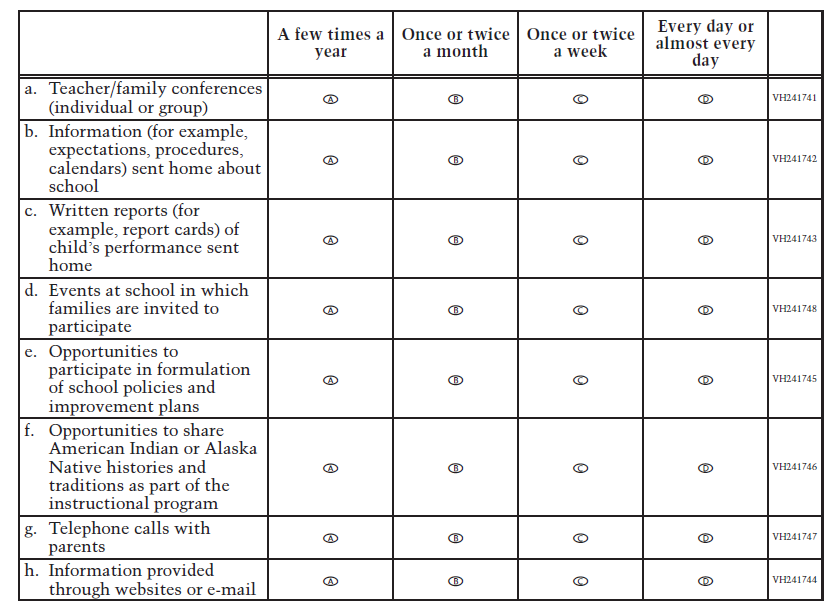
VH240184
19. What percentage of your grade 8 students dropped out of school during the last
schoolyear?
A 0–2%
B 3–5%
C 6–10%
D 11–20%
E 21–30%
F 31–40%
G 41–50%
H More than 50%
VH241749
20. Please indicate what percentage of the individuals at your school is described by
each of the following statements: Select one circle in each row.

VH240185
21. To what extent do your school’s eighth-grade curricula emphasize preparing
students for high school?
A Not at all
B Small extent
C Moderate extent
D Large extent
| File Type | application/vnd.openxmlformats-officedocument.wordprocessingml.document |
| Author | Molin, Ed C |
| File Modified | 0000-00-00 |
| File Created | 2024-07-23 |
© 2025 OMB.report | Privacy Policy